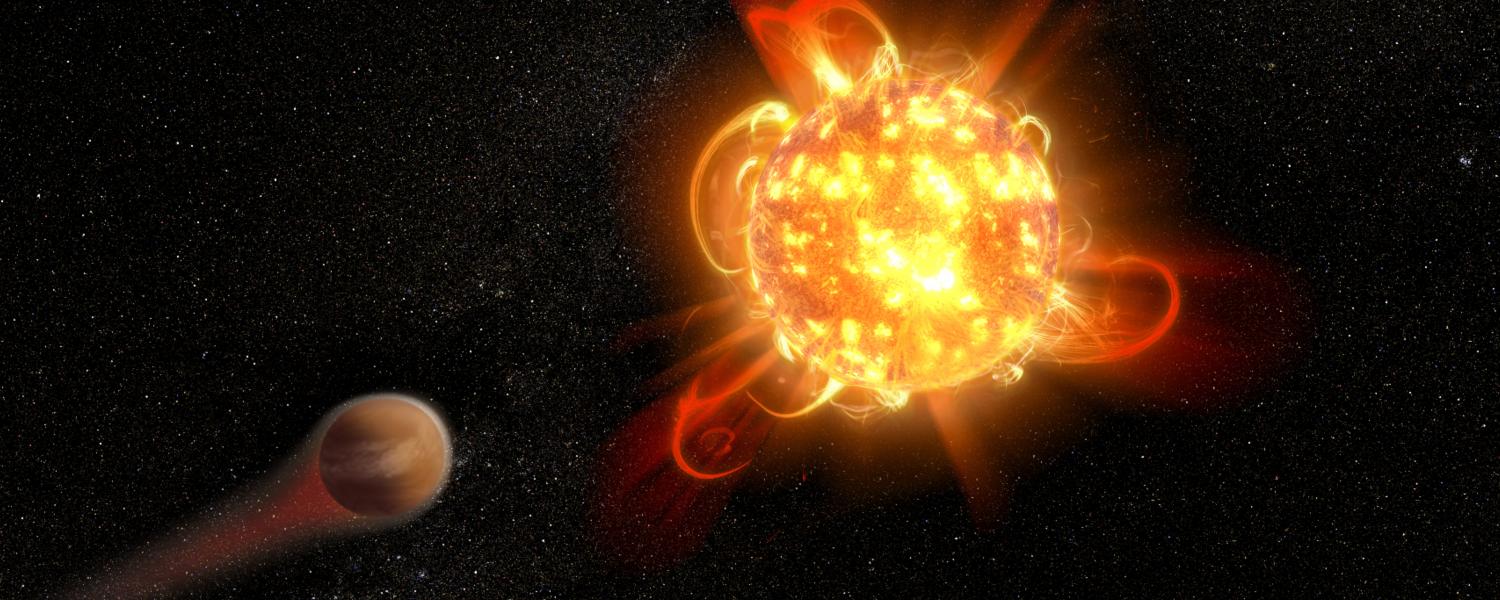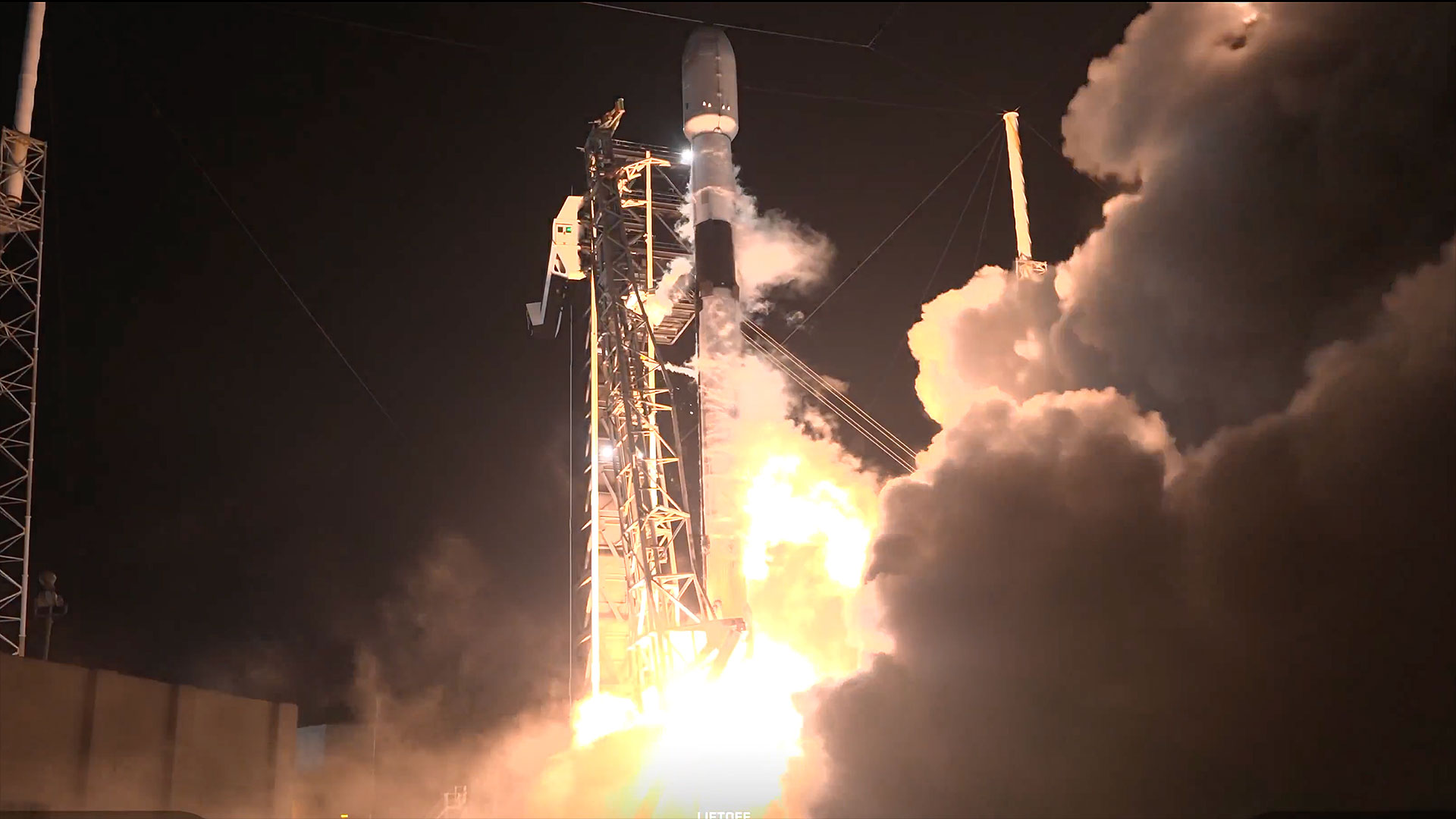
Powerful stellar eruptions could pose a serious challenge to the origin and evolution of life around the universe, a new study suggests.
Such outbursts throw off large amounts of ultraviolet (UV) radiation, which is not only directly harmful to life as we know it but can also strip away the atmospheres of relatively close-orbiting planets. These issues are especially pronounced for worlds circling red dwarfs, small and dim stars that make up about 75% of the Milky Way galaxy's stellar population.
For starters, red dwarfs are more active than sunlike stars, especially when they're young. And, because each red dwarf is so dim, its "habitable zone" — the range of orbital distances where liquid water could be stable on a world's surface — is much closer-in than for a star such as our sun.
Related: 10 exoplanets that could host alien life
The new study helps flesh out this skeletal outline. Researchers calculated the likely UV emissions generated by red-dwarf superflares, as well as the radiation loads absorbed by rocky planets that might reside in the small stars' habitable zones.
"We found planets orbiting young stars may experience life-prohibiting levels of UV radiation, although some micro-organisms might survive," study lead author Ward Howard, a doctoral student in the Department of Physics and Astronomy at the University of North Carolina (UNC), Chapel Hill, said in a statement.
Howard and his colleagues measured the temperatures of 42 superflares emitted by 27 red dwarfs. They did so by analyzing observations made simultaneously by the Evryscope, an array of small telescopes at the Cerro Tololo Inter-American Observatory in Chile, and NASA's Transiting Exoplanet Survey Satellite, which has been hunting for alien worlds from Earth orbit since 2018.
Breaking space news, the latest updates on rocket launches, skywatching events and more!
These observations were obtained every 2 minutes, allowing the scientists to get a detailed temperature profile across the brief life of the red-dwarf superflares, which typically emit most of their UV radiation during a 10- to 15-minute-long peak. Temperature is strongly correlated with UV emission, so the researchers were then able to estimate the radiation loads imposed by the outbursts.
The new information could aid a variety of other astrobiological investigations going forward, team members said.
“Longer term, these results may inform the choice of planetary systems to be observed by NASA's James Webb Space Telescope based on the system's flaring activity," study co-author Nicholas Law, an associate professor of physics and astronomy at UNC-Chapel Hill and the Evryscope principal investigator, said in the same statement.
The new study continues the team's ongoing investigation into red-dwarf flaring and its potential impacts on life. For example, a 2018 paper led by Howard suggested that superflares have dimmed the astrobiological potential of Proxima b, a rocky, Earth-size world that orbits in the habitable zone of the red dwarf Proxima Centauri, the sun's nearest stellar neighbor.
The new study has been accepted for publication in The Astrophysical Journal. You can read a preprint of it for free at arXiv.org.
Mike Wall is the author of "Out There" (Grand Central Publishing, 2018; illustrated by Karl Tate), a book about the search for alien life. Follow him on Twitter @michaeldwall. Follow us on Twitter @Spacedotcom or Facebook.
Join our Space Forums to keep talking space on the latest missions, night sky and more! And if you have a news tip, correction or comment, let us know at: community@space.com.

Michael Wall is a Senior Space Writer with Space.com and joined the team in 2010. He primarily covers exoplanets, spaceflight and military space, but has been known to dabble in the space art beat. His book about the search for alien life, "Out There," was published on Nov. 13, 2018. Before becoming a science writer, Michael worked as a herpetologist and wildlife biologist. He has a Ph.D. in evolutionary biology from the University of Sydney, Australia, a bachelor's degree from the University of Arizona, and a graduate certificate in science writing from the University of California, Santa Cruz. To find out what his latest project is, you can follow Michael on Twitter.
-
rod This report indicates Earth is not that good, perhaps there are superhabitable exoplanets now, Some planets may be better for life than Earth, https://phys.org/news/2020-10-planets-life-earth.htmlReply
My observation. This study shows that habitable earths orbiting class G stars (similar to our Sun) in the Milky Way, apparently is an idea largely abandoned now because of the more than 4300 exoplanets documented, not confirming habitable earths around other class G stars in the Milky Way apparently. Astrobiology using the *science* of abiogenesis for the origin of life is looking elsewhere today. This exoplanet site documents 4360 confirmed now, http://exoplanet.eu/catalog/, the NASA site has 4292 confirmed now, https://exoplanetarchive.ipac.caltech.edu/index.html
The search continues at Venus, Mars, Titan, some Jupiter moons, Enceladus, and among the stars. Using observation as a fundamental rule in science, we do see life here on Earth as well as a fossil record. Concerning observation, we see trees growing here :) -
logicalone2 Red dwarfs are small and potential habitable zone planets will not only be close to their stars. They will also tend to be tidally locked, which means one side will avoid direct effects of flares from sun. So, it seems like you could have habitable planets where one side was habitable and the other not so much.Reply -
Ed Stauffer Thought it was interesting that one of the criteria for a super habitable planet was that the temperature be 5 degrees Celsius warmer than the Earth. Hmmmm! Of course historically that was where the earth was in the past.Reply -
rod I note in the arxiv paper report, calls attention to a big issue with superflares at red dwarf stars. The measurements may be underestimating the energy level of UV radiation, UV energy that can evaporate an exoplanet orbiting the red dwarf in the habitable zone. It is a 14 page paper (PDF) but very interesting reading.Reply
https://arxiv.org/abs/2010.00604
I like the paper because specific red dwarfs are studied and efforts to define UV impact on possible exoplanets around red dwarf hosts. "ABSTRACT Superfares may provide the dominant source of biologically-relevant UV radiation to rocky habitablezone M-dwarf planets (M-Earths), altering planetary atmospheres and conditions for surface life..."
The key I see is *altering planetary atmospheres...* and what this could do for a habitable exoplanet around a red dwarf host.
